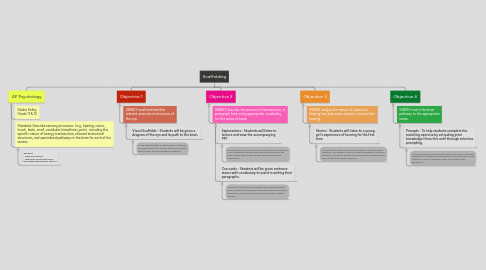
1. AP Psychology
1.1. Deidre Kelley Grade 11 & 12
1.2. Standard: Describe sensory processes (e.g., hearing, vision, touch, taste, smell, vestibular, kinesthesis, pain), including the specific nature of energy transduction, relevant anatomical structures, and specialized pathways in the brain for each of the senses.
1.2.1. Big Ideas - What are senses? - How does information from the outside world to our senses?
2. Objective 1
2.1. SWBAT recall and label the relevant anatomical structures of the eye.
2.1.1. Visual Scaffolds - Students will be given a diagram of the eye and its path to the brain.
2.1.1.1. Visual representation of the anatomy of the eye will allow students of various English proficiency equal access to the information presented.
3. Objective 2
3.1. SWBAT describe the process of transduction, in paragraph form using appropriate vocabulary, for the sense of taste.
3.1.1. Explanations - Students will listen to lecture and view the accompanying PPT
3.1.1.1. As transduction is a new concept, students will not have any prior knowledge and will require direct instruction on the topic before they are able to describe the process for themselves.
3.1.2. Cue cards - Students will be given sentence stems with vocabulary to assist in writing their paragraphs.
3.1.2.1. Sentence stems will assist students who are below grade level, as well as students who understand the concepts well but require assistance to articulate themselves in written English.
4. Objective 3
4.1. SWBAT analyze the nature of a person's hearing loss and create a plan to restore their hearing.
4.1.1. Stories - Students will listen to a young girl's experience of hearing for the first time.
4.1.1.1. To motivate students and increase interest in completing the objective, I will appeal to the low-road of persuasion: relying on emotions. This should engage students who may otherwise feel the material is dry and/or irrelevant.
5. Objective 4
5.1. SWBAT match the brain pathway to the appropriate sense.
5.1.1. Prompts - To help students complete the matching exercise by activating prior knowledge (from this unit) through selective prompting.
5.1.1.1. Circulating during individual work ("you do") to assess student progress and provide prompts based on individual need allows students of various readiness levels to succeed in the assignment.

